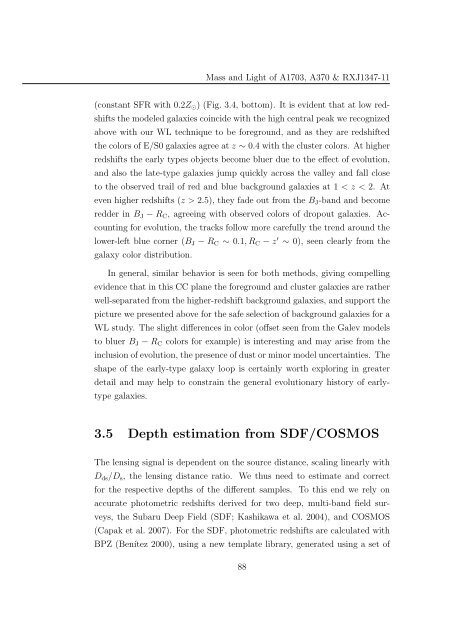Mass and Light distributions in Clusters of Galaxies - Henry A ...
Mass and Light distributions in Clusters of Galaxies - Henry A ...
Mass and Light distributions in Clusters of Galaxies - Henry A ...
You also want an ePaper? Increase the reach of your titles
YUMPU automatically turns print PDFs into web optimized ePapers that Google loves.
<strong>Mass</strong> <strong>and</strong> <strong>Light</strong> <strong>of</strong> A1703, A370 & RXJ1347-11<br />
(constant SFR with 0.2Z ⊙ ) (Fig. 3.4, bottom). It is evident that at low redshifts<br />
the modeled galaxies co<strong>in</strong>cide with the high central peak we recognized<br />
above with our WL technique to be foreground, <strong>and</strong> as they are redshifted<br />
the colors <strong>of</strong> E/S0 galaxies agree at z ∼ 0.4 with the cluster colors. At higher<br />
redshifts the early types objects become bluer due to the effect <strong>of</strong> evolution,<br />
<strong>and</strong> also the late-type galaxies jump quickly across the valley <strong>and</strong> fall close<br />
to the observed trail <strong>of</strong> red <strong>and</strong> blue background galaxies at 1 < z < 2. At<br />
even higher redshifts (z > 2.5), they fade out from the B J -b<strong>and</strong> <strong>and</strong> become<br />
redder <strong>in</strong> B J − R C , agree<strong>in</strong>g with observed colors <strong>of</strong> dropout galaxies. Account<strong>in</strong>g<br />
for evolution, the tracks follow more carefully the trend around the<br />
lower-left blue corner (B J − R C ∼ 0.1, R C − z ′ ∼ 0), seen clearly from the<br />
galaxy color distribution.<br />
In general, similar behavior is seen for both methods, giv<strong>in</strong>g compell<strong>in</strong>g<br />
evidence that <strong>in</strong> this CC plane the foreground <strong>and</strong> cluster galaxies are rather<br />
well-separated from the higher-redshift background galaxies, <strong>and</strong> support the<br />
picture we presented above for the safe selection <strong>of</strong> background galaxies for a<br />
WL study. The slight differences <strong>in</strong> color (<strong>of</strong>fset seen from the Galev models<br />
to bluer B J − R C colors for example) is <strong>in</strong>terest<strong>in</strong>g <strong>and</strong> may arise from the<br />
<strong>in</strong>clusion <strong>of</strong> evolution, the presence <strong>of</strong> dust or m<strong>in</strong>or model uncerta<strong>in</strong>ties. The<br />
shape <strong>of</strong> the early-type galaxy loop is certa<strong>in</strong>ly worth explor<strong>in</strong>g <strong>in</strong> greater<br />
detail <strong>and</strong> may help to constra<strong>in</strong> the general evolutionary history <strong>of</strong> earlytype<br />
galaxies.<br />
3.5 Depth estimation from SDF/COSMOS<br />
The lens<strong>in</strong>g signal is dependent on the source distance, scal<strong>in</strong>g l<strong>in</strong>early with<br />
D ds /D s , the lens<strong>in</strong>g distance ratio. We thus need to estimate <strong>and</strong> correct<br />
for the respective depths <strong>of</strong> the different samples. To this end we rely on<br />
accurate photometric redshifts derived for two deep, multi-b<strong>and</strong> field surveys,<br />
the Subaru Deep Field (SDF; Kashikawa et al. 2004), <strong>and</strong> COSMOS<br />
(Capak et al. 2007). For the SDF, photometric redshifts are calculated with<br />
BPZ (Benítez 2000), us<strong>in</strong>g a new template library, generated us<strong>in</strong>g a set <strong>of</strong><br />
88
















